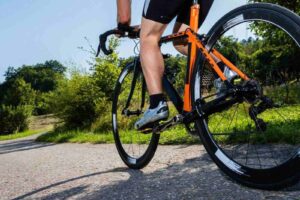Table of Contents
- Introduction
- Health Benefits of Cycling
- Choosing the Right Bike and Gear
- Setting Realistic Goals
- Structuring Your Cycling Routine
- Proper Riding Techniques
- Nutrition and Hydration Tips
- Overcoming Challenges and Staying Motivated
- Safety Tips and Precautions
- Tracking Progress and Celebrating Achievements
- Conclusion
Introduction
Cycling isn’t just a means of transportation; it’s a powerful tool for weight loss. In this guide, we’ll explore how cycling can be a game-changer for those seeking to shed pounds. We’ll also emphasize the significance of pairing cycling with a balanced diet for optimal results.
Health Benefits of Cycling
Increasing Metabolism for Weight Loss
Cycling revs up your metabolism, leading to more efficient calorie burning. This metabolic boost continues even after you’ve finished your ride, making it a potent tool for weight loss.
Cardiovascular Health and Fitness
Regular cycling strengthens your heart and lungs, improving overall cardiovascular health. It’s a low-impact exercise, reducing strain on joints while providing an excellent cardiovascular workout.
Mental Health and Stress Reduction
Cycling isn’t just beneficial for the body; it’s great for the mind too. The endorphins released during a ride help alleviate stress and boost mood. It’s a fantastic way to unwind and clear your mind.
Choosing the Right Bike and Gear
Types of Bikes for Beginners
Choosing the right bike is crucial. For beginners, options like road bikes or hybrids offer a good balance of efficiency and comfort. Consider factors like terrain and intended use when making your choice.
Ensuring the Right Fit
A well-fitted bike is essential for comfort and efficiency. Pay attention to factors like saddle height, handlebar position, and frame size. Consulting a professional at a local bike shop can be invaluable.
Essential Gear for Safety and Comfort
Safety should always come first. Invest in a quality helmet, padded shorts for comfort, and gloves for grip and protection. Additionally, consider lights and reflective clothing for visibility, especially during low-light conditions.
Setting Realistic Goals
Short-term and Long-term Targets
Setting achievable goals is a cornerstone of any successful fitness journey. Define both short-term goals (e.g., weekly mileage targets) and long-term goals (e.g., total weight loss over a few months).
Tracking Progress
Documenting your progress provides motivation and insight. Keep a record of your rides, including distance, duration, and any weight loss milestones. Tracking apps and wearable devices can be invaluable tools.
Consistency and Gradual Progression
Consistency is key in any fitness endeavor. Start with manageable distances and gradually increase intensity. This approach not only prevents burnout but also allows for steady, sustainable progress.
Structuring Your Cycling Routine
Designing a Balanced Workout Schedule
A well-structured workout plan ensures you target different aspects of fitness. Include a mix of endurance rides, interval training, and recovery days. This variety keeps things interesting and maximizes results.
Incorporating Intervals and Variations
Intervals, alternating between high and low intensity, are incredibly effective for weight loss. They boost metabolism and increase calorie burn. Additionally, vary your routes and terrain to keep your body challenged.
Allowing for Rest and Recovery
Rest days are not to be overlooked. They allow your body to recover and adapt to the demands of cycling. Overtraining can lead to burnout and potential injuries, so listen to your body’s signals.
Proper Riding Techniques
Mastering Posture and Body Positioning
Proper posture ensures comfort and efficiency during rides. Keep your back straight, elbows slightly bent, and eyes forward. Distribute your weight evenly between the saddle and handlebars.
Efficient Pedaling and Cadence
Smooth, efficient pedaling is a skill that comes with practice. Aim for a cadence (pedal revolutions per minute) of around 80-100. This balance between speed and resistance optimizes your effort.
Handling Different Terrains
Different terrains demand different techniques. For example, stand on pedals for steep inclines, and shift your weight back for descents. Familiarize yourself with these techniques for a smoother ride.
Nutrition and Hydration Tips
Supporting Weight Loss with a Balanced Diet
Cycling and diet go hand in hand. Focus on nutrient-dense foods like lean proteins, whole grains, fruits, and vegetables. Stay mindful of portion sizes to maintain a calorie deficit.
Hydration for Endurance and Energy
Proper hydration is crucial for sustained performance. Drink water before, during, and after rides. Consider electrolyte-rich beverages for longer sessions. Listen to your body’s signals for thirst.
Overcoming Challenges and Staying Motivated
Addressing Common Hurdles
Muscle soreness, time constraints, and weather are common challenges. Have strategies in place, like stretching routines, time management, and indoor cycling options for adverse conditions.
Cultivating Long-term Motivation
Consistency is the linchpin of success. Find what motivates you, whether it’s setting personal records, exploring new routes, or joining a cycling group. The sense of achievement will fuel your progress.
Tapping into the Community Aspect
Cycling communities offer support and camaraderie. Joining local clubs or online forums connects you with like-minded individuals who share tips, experiences, and encouragement.
Safety Tips and Precautions
Obeying Traffic Rules and Road Safety
Safety on the road is paramount. Familiarize yourself with local traffic laws and always wear a helmet. Use hand signals, be aware of your surroundings, and follow established cycling routes.
Bike Maintenance and Pre-Ride Checks
A well-maintained bike is a safe bike. Regularly inspect brakes, tires, and gears. Lubricate moving parts and ensure everything is in working order before heading out.
Visibility in Low-light Conditions
Being seen is crucial, especially in low-light situations. Equip your bike with lights, and wear high-visibility clothing. Reflective accessories and bright colors significantly enhance your visibility.
Tracking Progress and Celebrating Achievements
Utilizing Apps and Wearable Devices
Technology can be a powerful ally. Use cycling apps and wearable devices to monitor your rides, track progress, and set new goals. These tools provide invaluable data for fine-tuning your routine.
Celebrate Milestones
Acknowledge and celebrate your achievements, no matter how small. It could be reaching a mileage goal, hitting a weight loss target, or conquering a challenging route. Recognizing your progress reinforces your commitment.
Reflecting on Overall Well-being
Beyond physical changes, reflect on how cycling has positively impacted your overall well-being. Improved fitness, reduced stress, and a sense of accomplishment are all part of the journey.
Conclusion
Embarking on a cycling journey for weight loss is a transformative endeavor. By combining the physical benefits of cycling with a balanced diet, you’re setting yourself up for success. Get on that bike, set your goals, and watch the pounds melt away. Your journey to a healthier, fitter you starts now!




